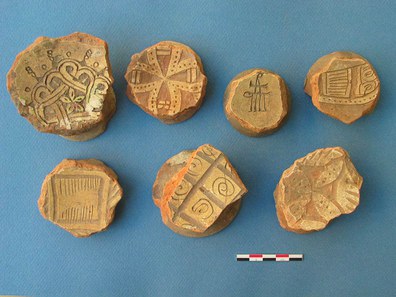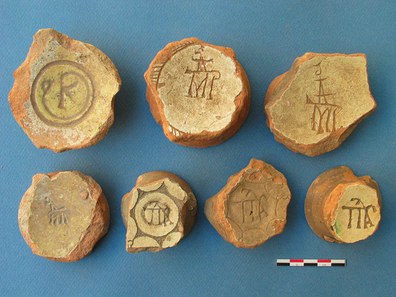Introduction
The rescue excavations undertaken in Istanbul by the Archaeological Museum of Istanbul, in the framework of the MARMARAY infrastructure project, recently unearthed the remains of one or several ceramics workshops. Dated back to the late Byzantine and early Ottoman periods, they are located in the district of Sirkeci, at the periphery of what used to be the main imperial and ecclesiastic complex of Constantinople.
This exceptional discovery provides, for the first time, the opportunity to study the manufacture of ceramics in Istanbul during the Byzantine period. With the help of chemical analysis, our project intends to provide a corpus of reference data corresponding to these productions. The new reference groups could then be used to test the attribution to Constantinople of several categories of ceramics. As the capital of the Byzantine empire, the city has always been considered the origin of many ceramics productions, due to the relative abundance and persistence of similar fabrics in the Ottoman period (Byzantine White Ware, Hayes 1992), or to the quality of execution and large scale of diffusion (e.g. Zeuxippus Ware, Megaw 1968). But until the Sirkeci excavations no archaeological evidence had come to confirm these hypotheses.

Excavations at Sirkeci
The excavations were directed first by Çiğdem Girgin, then by Nihal Erhan and Suleyman Eskalen, under the supervision of Ismail Karamut, director of the Istanbul Archaeological Museum. Although a structure that might be interpreted as a kiln was unearthed in 2005 (Girgin 2007), no further structure of pottery production has been found so far. But the large quantities of pottery dump found in the Sirkeci excavations attest to the vicinity of ceramics workshops.
The pottery dump mainly consists of kiln furniture and biscuit-fired pottery, that is, of unfinished ware rejected after a first firing and before the application of a glaze. The biscuits were slipped and usually decorated with the sgraffito or the champlevé technique.
First approach of the Sirkeci repertoire

Although our study did not intend to be a typological one, a first approach of the repertoire of the Sirkeci production could be done, thanks to the ceramics wasters and to chemical analysis (Waksman et al. 2009). This repertoire includes a variety of motifs, some of which related to previously studied categories. For instance, monograms enable us to date (part of) the production to the late Byzantine, and more precisely to the Palaiologan period, according to previous studies (Papanikola-Bakirtzi 1999). Others may be related to Elaborated Incised Ware (François 2003), to Zeuxippus Ware class I (Megaw 1968), and possibly to Westliche Sgraffitoware (Böhlendorf Arslan 2004). A bird motif reminds of the so-called Thessaloniki bird, only known up till now from the Thessaloniki workshops (Papanikola-Bakirtzi 1999).
This part of the study benefited from the assistance of Burçe Tuz, Nurcan Çalık and Nilgün Örnek, archaeologists of the Sirkeci team.
Chemical analysis and reference groups
Chemical analysis were carried out by wavelength-dispersive X-ray fluorescence at the Laboratoire de Céramologie in Lyon (France). Twenty-four major and trace elements are determined in ceramics samples, 17 of which are currently used in multivariate analysis that enable to classify samples according to their chemical composition.

Three reference groups, corresponding to the productions of Sirkeci, could be defined. The main one (S2) includes the majority of the samples and the largest typological variety: Elaborate Incised Ware, ceramics decorated with monograms, with birds and other figurative motifs, ceramics related to Zeuxippus Ware class I, etc. This production is made out of a non-calcareous clay. The two other groups are also constituted of non-calcareous clays, but unlike the previous one their paste may be considered kaolinitic, due to high aluminum, low alcaline elements, and manganese contents. The second group (S3) possibly corresponds to an early Ottoman production, noted by the application of sgraffito technique on a kaolinitic paste. The third group is a very small one (S1, two samples), but of interest since it presents profiles similar to Glazed White Ware Ⅱ (Hayes 1992). In spite of this typological similarity, group S1 is quite different chemically from Glazed White Ware II samples from the Saraçhane excavations (Waksman and Girgin 2008). In the present state of research, the Sirkeci material cannot confirm the hypothesis of a Constantinopolitan production of Glazed White Ware Ⅱ. Neither do the other groups confirm the local manufacture in Istanbul of several other categories, including Zeuxippus Ware and Orange Brown Glaze Ware (Hayes 1992) or Novy Svet Ware (Waksman and François 2004–05).
Conclusions
This project grant enabled us to study and characterize chemically the first production of Byzantine ceramics attested by archaeology in Istanbul. Partly dated to the Palaiologan period, its repertoire includes Elaborate Incised Ware, ceramics decorated with monograms or related to Zeuxippus Ware class I. It also includes bird motifs similar to those produced and previously attributed to Thessaloniki. The Sirkeci repertoire gives a complex picture of ceramics production in the late Byzantine period, with multiple and mutual typological and stylistical influences.
Chemical analysis enabled us to define the first reference groups corresponding to undoubtedly Constantinopolitan productions. These may be used to test the attribution to the Byzantine capital of several types of ceramics. They may also help precising the fluxes of exchanges and the respective economic role of the great late Byzantine cities, as may be seen through ceramics study. The excavations at Sirkeci in Istanbul give us an exceptional opportunity to study ceramics production in the Byzantine capital. But our results only give some clues in a field still largely to be investigated.
Bibliography
- Böhlendorf Arslan, B. 2004. Glasierte byzantinische Keramik aus der Türkei. 3 vols. Istanbul: Ege Yayınları.
- François, V. 2003. "Elaborate Incised Ware: un témoin du rayonnement de la culture byzantine à l'époque paléologue." Byzantinoslavica 61:151–68.
- Girgin, Ç. 2007. "Sirkeci'de sürdürülen kazı çalışmalarından elde edilen sonuçlar." In Gün Isiginda: Istanbul'un 8000 yili: Marmaray, Metro, Sultanahmet kazıları, 98–105. Istanbul: Vehbi Koç Vakfı.
- Hayes, J. W. 1992. Excavations at Saraçhane in Istanbul, vol 2, The Pottery. Princeton: Princeton University Press / Washington, DC: Dumbarton Oaks Research Library and Collection.
- Megaw, A. H. S. 1968. "Zeuxippus Ware." BSA 63:67–88.
- Papanikola-Bakirtzi, D., ed. 1999: Byzantine Glazed Ceramics. The Art of Sgraffito, Athens.
- Waksman, S. Y., François, V. 2004–05: "Vers une redéfinition typologique et analytique des céramiques byzantines du type Zeuxippus Ware." BCH 128–129.2:87–182.
- Waksman, S. Y., and Ç. Girgin. 2008. "Les vestiges de production de céramiques des fouilles de Sirkeci (Istanbul). Premiers éléments de caractérisation." Anatolia Antiqua 16:443–68.
- Waksman, S. Y., N. Erhan, N., and S. Eskalen. 2009. "Les ateliers de céramiques de Sirkeci (Istanbul). Résultats de la campagne 2008." Anatolia Antiqua 17:457–67.